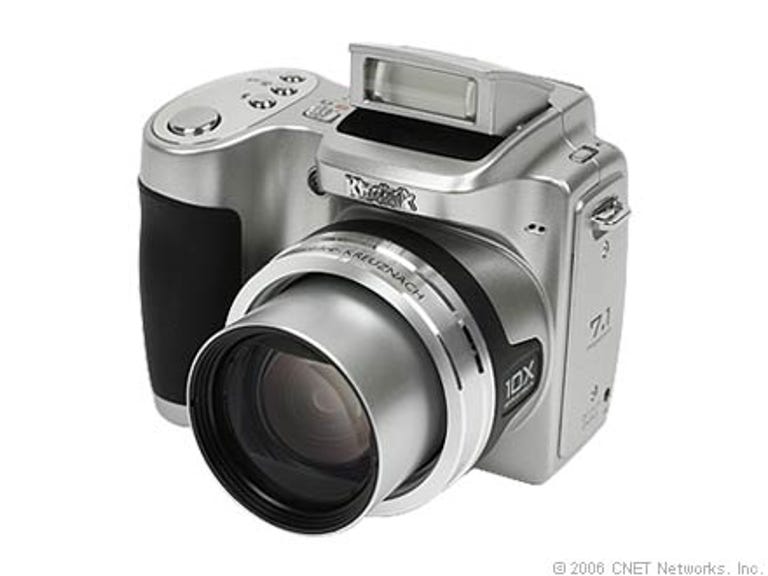 Why You Can Trust CNET
Why You Can Trust CNET Kodak EASYSHARE Z710 - digital camera review: Kodak EASYSHARE Z710 - digital camera
Kodak's Z710 has some nice features and a good lens, but slow performance, no image stabilization, and a limited ISO range drag it down.
The camera's design is like a cross between the EasyShare Z612 and Z650, with a shiny silver plastic plate atop a rubberized grip. The plate houses the shutter button, along with controls for flash, macro or landscape mode, and drive mode. Since all controls are on the right side of the camera, with the exception of the slider that makes the flash pop up, one-handed shooting is possible. But if you relish the stability offered by two-handed shooting, something we always recommend, the rubber ring around the lens barrel will help you keep your grip. The 2-inch LCD is small for a camera of this class, though it didn't wash out too much when shooting outdoors in our tests. The EVF boasts 201,000 pixels but its images look somewhat coarse compared to others we've seen. The most annoying thing about the Z710's design is that the flash pops up every time you turn the camera on. You'll have to break out the duct tape if you get sick of pushing it back down.
The Good
The Bad
The Bottom Line
Like other recent Kodak cameras, the Z710's controls are rather intuitive. A large dial on the camera back lets you choose your shooting mode, though all manual exposure modes, as well as program, are grouped under one setting. This may seem strange, but it lets you switch between manual, and aperture- or shutter-priority quickly using the tiny joystick, which also lets you change shutter speed, aperture, ISO, and exposure compensation. All these values are displayed on the LCD, so all you have to do is navigate from one to the next and change them as needed. It's a comfortable and efficient design. Unfortunately, the joystick has a smooth plastic coating over it. A rubber or textured finish would've made it much easier to use. Our thumbs frequently slid off the bottom of it when adjusting settings.
All the efficient controls don't help the fact that the EasyShare Z710 performed very slowly in our performance tests. The camera took a snail-like 5.5 seconds to power up and capture its first image. Capturing subsequent images, the Z710 took 2.8 seconds between shots with the flash turned off, and 2.9 seconds with flash enabled. Our shutter lag results were somewhat strange. In our high-contrast test, intended to mimic bright lighting conditions, shutter lag measured 1.6 seconds. Thanks to the camera's bright focus-assist lamp, which didn't activate in our high-contrast test, the Z710 only took 0.7 second in our low-contrast test, which mimics low-light shooting. Continuous shooting is limited to three shot bursts, but the camera was able to capture an impressive average of 2.5 frames per second regardless of image size.
The EasyShare Z710's image quality was neither bad nor impressive in our tests. As usual, colors were accurate and adequately saturated. At lower ISOs, the camera was able to capture oodles of detail; we were even able to discern the individual hairs on the plush ape in our test scene. The camera's high-quality lens no doubt helped in this and showed almost no noticeable distortion, even at the wide and telephoto extremes of its zoom range. Most superzooms show at least some noticeable distortion at one of the extremes if not both. As is typical of Kodak, we saw some minor JPEG artifacts in images, which caused some curved lines to become jaggy, though most causal snapshooters might not notice this.
We saw almost no noise at ISO 64, though there was a slight mottling of darker colors that didn't show up in prints, but was visible on monitors. ISO 100 showed similar mottling, though noise was still very minor and mostly not noticeable. At ISO 200, noise became slightly more noticeable, manifesting itself as off-color dots instead of the fine snowy white speckles that some cameras produce. Also, we began to see a softening of finer details. At ISO 400, noise was very noticeable. Though the noise wasn't as bad as we've seen in some Kodak cameras, we saw a significant loss of detail at ISO 400. Kodak does offer a boost to ISO 800, but it cuts the resolution to 1.9 megapixels, which isn't even enough for sharp 4x6-inch prints. Given that most cameras now extend up to ISO 800 at full resolution, and some up to ISO 1,600 or ISO 3,200, it's bizarre that Kodak still can't offer anything higher than ISO 400 at full resolution.
Given this camera's slow performance and limited ISO range, it's hard to recommend it, especially when Kodak has better-performing models in its own line, such as the EasyShare Z612. There aren't many other superzooms in this price range, though for slightly more money you could try Sony's 6-megapixel Cyber Shot DSC-H2 or Canon's 5-megapixel PowerShot S2 IS, both of which offer optical image stabilization, which this Kodak sorely lacks.
(Shorter bars indicate better performance)
| Typical shot-to-shot time | Time to first shot | Shutter lag (typical) |
(Longer bars indicate better performance)
